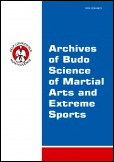2021, Volume 17, Issue 1
Exercises and sets of exercises diagnosing the ability to optimally use muscle strength – part II: upper limbs
Roman Maciej Kalina1
1EKO-AGRO-FITNESS Prof. Roman M. Kalina, Piwniczna-Zdrój, Poland
Author for correspondence: Roman Maciej Kalina; EKO-AGRO-FITNESS Prof. Roman M. Kalina, Piwniczna-Zdrój, Poland; email: kom.kalina@op.pl
Full text
Abstract
The phenomenon of ability to optimally use the muscle strength (AOUMS) was defined in the most general terms by the author in the first work dedicated to this issue. In addition, the author presented in that publication the general assumptions and the method of measuring the AOUMS of the lower limbs. The aim of this paper is to recommend a simple set of exercises for diagnosing upper limbs AOUMS.
Diagnosing of upper limbs AOUMS (quasi-apparatus version): baseball throws (dominant hand first) in a relatively isolated posture (heels, buttocks and back pressed against the wall). The quality of isolated posture was controlled in such a way that the tested person must to press 4 sheets of paper against the wall with the muscles of the back and buttocks. The attempt was considered valid if the card or cards did not fall during the throw of the ball. The throw distance was determined using a measuring tape with an accuracy of 1 cm.
The other evaluation criteria are the same as when measuring AOUMS lower limbs, that means: the minimum set of diagnostic exercises for alternating eyes open – eyes covered must consist of six exercises, respectively one throw with the use of force according to the model: first throw 50% of the sense of maximum strength with open eyes; second throw between 5% to 45% of the feeling of this force with covered eyes; 65% to 95%- open eyes; 50%- covered eyes; 5% to 45%- eyes open; 65% to 95%- covered eyes; the series of six exercises ended with three trials with eyes open, each at 100% (the farthest throw was the frame of reference for measuring the conformity of each score to the model expressed in %).
The exposure model used as a function of force time (first with the dominant hand, then with the non-dominant hand) was identical to that for measuring the AOUMS of the lower limbs. Thus, combining both models (starting with measuring the AOUMS of the upper limbs according to the described methodology) is a simple, unique, low-cost method to measure this phenomenon in a complementary way. Such a conclusion is justified by the common truth that most of the basic motor activities of everyday life are performed by humans using the upper and lower limbs (apart from proportions).
Key words: complementary way, methodology, ‘power precision’, ‘sensation energies’





